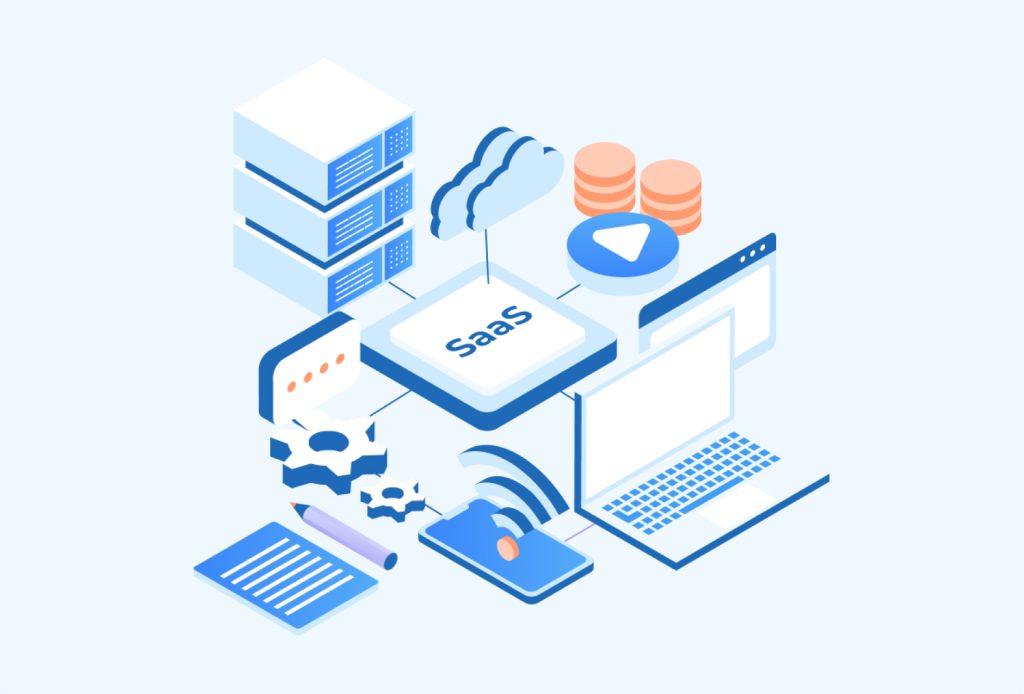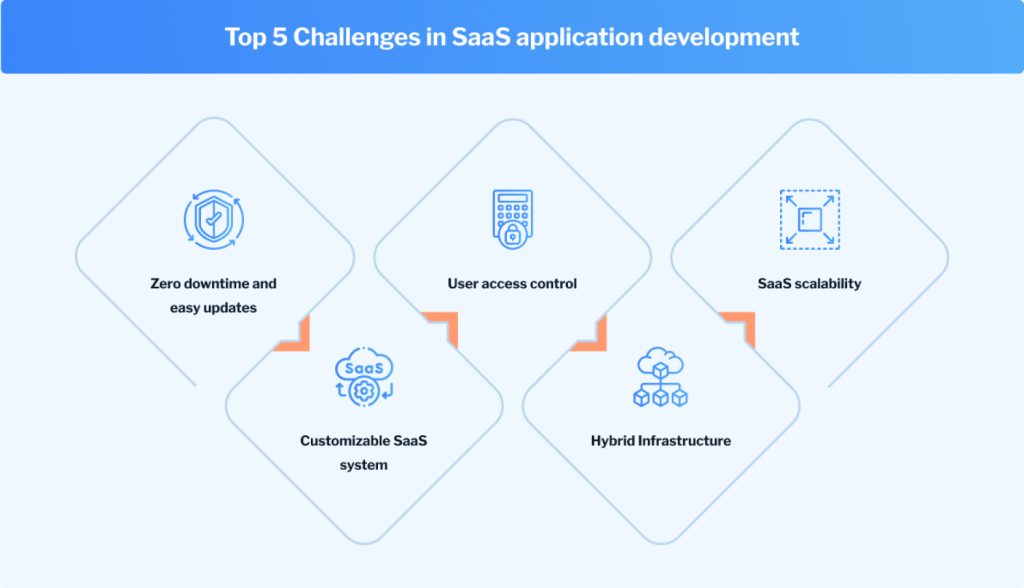We use cookies to ensure we give you the best experience on our website. By clicking Agree you accept our Privacy and Cookies Policy.
How to overcome challenges in SaaS development: hints from SaaS developers
Oleh Havrylyuk
Author

March 3, 2024
Date

 11 minutes read
11 minutes read
Content
This article will explore some of the biggest challenges SaaS software developers face and provide practical tips for overcoming them. We’ll also touch on some common mistakes that can trip up even experienced teams and share how to avoid them based on our experience in SaaS application development.
But before we get this party started, let’s find out why companies should build SaaS in the first place.
Why should you build SaaS application?
The SaaS industry has increased by around 500% over the past 7 years and is expected to grow at an alarming rate.
SaaS offers many benefits over traditional software, including lower upfront costs, scalability, and flexibility. But perhaps the most compelling reason for businesses to develop their own SaaS application is the competitive advantage it can provide.
With SaaS, businesses have direct control over their data and how it’s used. They can also tailor the app’s functionality to meet their needs perfectly – something that would be much more difficult (and costly) with an off-the-shelf solution. By having a unique SaaS product, businesses can set themselves apart from their competitors who are still using legacy systems or generic solutions.
In addition to giving businesses a competitive edge, developing a SaaS application can also help them save money in the long run. Plus, since there’s no need to install anything on local servers or computers, companies can avoid expensive infrastructure costs as well.
Besides, SaaS platforms are typically easier to develop and deploy than traditional on-premises software applications, and they offer a number of advantages for both users and developers. However, SaaS can present some challenges during development, testing, and deployment.

Top 5 challenges in SaaS application development
Zero downtime and easy updates
When developing SaaS, it is crucial to plan for zero downtime during updates and deployments. Downtime can be costly for your business, so it is vital to have a plan in place to avoid it.
Downtime can occur for various reasons, including planned maintenance or unexpected outages. Zero downtime means that your customers can always access your product, even during scheduled maintenance windows. This ensures they can continue to use your product without interruption and reduces the risk of losing customers due to an unavailable service.
In order to achieve zero downtime, you need to have a robust system in place that can handle failovers and provide continuous availability. This may include using multiple data centers, load balancing across servers, and having a comprehensive monitoring system in place. At this point, it’s crucial to involve a skilled software testing team.
Our experience shows that blue/green deployment is one of the most effective approaches to achieving zero downtime.
Implementing blue/green deployments in SaaS software development can be a very effective way to reduce the risk of introducing new code into a production environment. By using two identical production environments, one for the “blue” version and one for the “green” version, you can effectively test new code in a production-like setting without impacting your users.
There are a few different ways to set up your blue/green deployment environment, but one of the most common is to use two separate application servers – one for each color. Then, when you’re ready to deploy your green code, simply switch traffic over to the green server while keeping the blue server online as well. This gives you an instant fallback should anything go wrong with your green deployment.
If done correctly, blue/green deployments can be totally transparent to your users – they’ll never even know that there’s been a change made behind the scenes! Plus, it prevents potential SaaS testing challenges. Since your testing is done in advance on an identical system, you can be confident that what works in staging will also work in production.
Customizable SaaS system
SaaS developers encounter two main challenges when designing a custom solution: managing complexity and ensuring consistency across different implementations.
Managing complexity means keeping things simple so they can be used by customers without technical expertise. This approach involves creating no-code or low-code solutions by breaking down features into manageable chunks. These chunks can be reused as building blocks in different configurations, providing flexibility while still maintaining some level of orderliness. This brings us to the second challenge – consistency.
Ensuring app consistency is critical when dealing with potentially unlimited permutations – something you definitely don’t want unless you have infinite resources (and even then!). This involves a joint effort of UX/UI designers and SaaS application developers.
Here are some of the common ways how inconsistency can creep into a SaaS app – and how you can address them:
- Layout inconsistencies. If you’re not careful, minor discrepancies in spacing or font size can cause layout problems on different devices. You can avoid this by using a CSS grid system, which will automatically adjust your layouts based on the device’s screen size.
- Bugs and glitches. They can occur when two parts of the code don’t work together properly or when there’s a mismatch between the front-end and back-end systems. To minimize these errors, make sure you have comprehensive testing procedures in place for every new release of your app all the way through the SaaS development process. You should also use automated testing tools whenever possible to catch any potential bugs before they become a problem.
- Data inconsistency. This can happen if different parts of the code are implemented independently without proper coordination or if there’s a delay in syncing data between servers. To make sure it won’t happen, all your coding teams should know how each component interacts with others and test extensively before releasing updates.
Here’s how we deal with customization challenges in Blackthorn Vision. Depending on our client’s priorities and needs, we provide limited options through an administrative interface or design all parts of the SaaS system using standard components which customers could assemble into their own configurations. Another approach is to create SaaS application framework with hooks and filters that allow users to customize aspects of behavior without any programming.

User access control
Adding authentication and authorization functionality to web-based SaaS applications can be a complex task. Developers need to create custom code for handling sign-in procedures, managing session data, checking permissions, and more. Aside from spending extra time, software engineers also jeopardize their code to bugs.
How do we deal with used access challenges when we build a SaaS product? We use Azure Active Directory. It was created specifically to address the problem by providing a simple way for SaaS developers to incorporate these features into their apps using pre-built components. It also provides more control to administrators, so they can manage who has access to resources within their organization’s infrastructure.
In addition, Azure AD integrates with popular SaaS services such as Office 365, so users authenticated via AAD can seamlessly collaborate with colleagues within Office 365 without having separate usernames or passwords for each service.
From the perspective of SaaS application developers, integrating with Azure AD is simple: they just need to include a few lines of code in their application. This code detects whether the user is logged in through AAD and handles authentication and authorization accordingly.
If you’re interested in incorporating Azure Active Directory into your SaaS project but aren’t sure how to get started, our SaaS software developers are ready to assist on every step!
Hybrid infrastructure
Virtually every organization is moving away from a single-cloud strategy and incorporating multiple cloud providers into their IT mix.
The advantages of this multi-cloud approach are many: businesses can tap into different providers’ strengths, avoid vendor lock-in, and better manage costs. However, as more companies move to a hybrid infrastructure model, there is an increased demand for software that can easily run on both public and private clouds. This is where SaaS development challenges tap in.
Building SaaS applications that can be flexibly deployed across different environments without sacrificing performance or functionality can be tricky. One of the key issues with developing SaaS solutions for hybrid environments is ensuring compatibility with private and public clouds.
While some clouds may share certain similarities (e.g., Amazon Web Services’ Elastic Compute Cloud shares features with Microsoft Azure), others may have significant differences which need to be accounted for when building your application codebase. For example, certain functions or services offered by one cloud provider might not be available on another platform. So you’ll need to make sure your SaaS app can still effectively run even if it’s stripped down to essentials.
That’s why we use Azure Cloud services in our SaaS application development projects. Azure provides everything you need to develop, deploy and manage SaaS applications at scale. Besides, since you have access to all of Microsoft’s developer tools and resources, it eliminates possible SaaS integration challenges.
Our cloud developers prefer implementing hybrid infrastructure on Azure because of the flexibility it gives. You can choose which apps and services go into the cloud and which stay on-premises, giving you more control over your IT environment. Additionally, workloads running in Azure can be easily migrated between environments as needed. This makes scaling up or down much simpler than hosting everything in one location.
SaaS scalability
One of the biggest challenges facing SaaS developers is scalability — the ability to handle increased loads without negatively impacting performance or availability efficiently.
To meet the needs of their customers, SaaS companies must be able to quickly and easily scale up or down as needed. But this isn’t always easy to do. In many cases, it requires a complete rethinking of how application architecture is designed and implemented.
Issues associated with SaaS scalability also include database scaling. As data volumes increase, organizations face pressure to vertically scale their databases by adding more CPU power and memory resources. However, this approach can quickly become cost-prohibitive.
An alternative solution is to horizontally scale the database by sharding — or splitting — it into multiple smaller pieces that can be spread across multiple servers. This approach can be more complex to implement but often provides a better bang for your buck in terms of overall cost efficiency.
Another big challenge related to scalability is dealing with sudden spikes in traffic or usage levels — “flash crowds,” as they’re sometimes called. These spikes can occur for any number of reasons: a popular blog post sends users flooding onto a site, an email marketing campaign generates a wave of click-throughs, etc. If not anticipated and planned for properly ahead of SaaS platform development, flash crowds can bring even the most robustly built systems crashing down under strain.
Our architects design what’s known as “self-scaling” systems that can dynamically adjust capacity based on current load conditions, empowering rapid SaaS development. So, if traffic starts picking up unexpectedly, extra capacity will automatically come online – preventing potential service outages.
Time-tested solutions from top-rated SaaS developers
When it comes to picking a SaaS application development company, there are a lot of different options out there. But how do you know which one is the best?
The answer is simple: look for client testimonials and qualifications of their SaaS software developers. Companies that have been in the business for years have proven themselves time and time again. They also tend to offer a wide range of services, so you can be sure that they’ll be able to meet your needs.
Blackthorn Vision has over a decade of experience in SaaS platform development with dozens of successful projects across industries. As one of the top software developers based on Clutch reviews, we provide our customers with the necessary tools and skilled, dedicated developers to create custom SaaS software solutions.
We understand the importance of creating quality SaaS products that meet the specific needs of our clients. That’s why we offer a wide range of SaaS development services to help them succeed. Our primary focus is on delivering high-quality SaaS software solutions that are easy to use and scalable. We want our clients to grow their businesses without worrying about technical constraints.
So if you’re facing any SaaS challenges and want to take advantage of our SaaS development services, don’t hesitate to get in touch today. We’ll be more than happy to discuss your needs and see how we can help.




























































